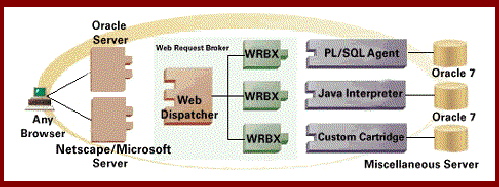The Oracle WebServer enables the creation of HTML documents from data stored in an Oracle database. When the data changes, the HTML documents are updated automatically, with no further effort on the part of the site administrator. This approach supplements the presentation of static, or unchanging, data that is found on most Web sites today, with the dynamic real-time data present in business systems based on the Oracle7 Server.
Business data is stored on the Oracle7 Server. It is formatted into Web documents within the server and then transmitted to Web clients. All data is stored only once, eliminating the need to "snapshot" data periodically for use on the Web.
The components that make up the Oracle WebServer work together to make the delivery of both static and dynamic pages possible.
Architecture

Oracle WebServer 2.1 Components
- Web Request Broker (WRB) - a high-performance, multi-threaded, multi-process application server.
- Web Server SDK - an open application platform that delivers seamless integration with Oracle7 databases and the most popular Web application development environments.
Web Request Broker (WRB)
The Web Request Broker Services are object services compliant with the CORBA architecture. Web clients connect to the Oracle WebServer using HTTP just like any other web server. A request is delivered in the form of a URL (Uniform Resource Locator), which conceptually is an identifier for a web object (normally an HTML page). The HTTP engine does not make any attempt at interpreting the URL, instead it is handed over to the Web Request Broker for further processing. In short, Oracle WebServer delivers dynamic HTML pages directly through the Web Request Broker.The Web Request Broker consists of –
- Web Listener
The Oracle Web Listener is a commercial quality HTTP server that services document requests from any Web browser. Clients can be located anywhere on a network using the standard HTTP protocol. Under this protocol, the type of the document is sent to the client along with the document itself. Many different document types are supported. Clients both interpret and display the document appropriately, or pass the document to a program that specifically handles that document type.
The Oracle Web Listener can handle a large number of simultaneous requests. When the Oracle Web Listener receives a request from a client, it first determines whether that request is for a static document or a dynamic document. If the request is for a static document, the Web Listener sends the file and the associated type information directly to the client. If the request is for a dynamic document, it is created "on the fly" by a program invoked by the Web Listener, in compliance with the Common Gateway Interface (CGI).
CGI is an interface that enables HTTP servers to run a program and use the output of that program in a document that are sent to the user. Most HTTP servers support this interface, and the Oracle Web Listener hands off everything else to the Web Request Broker, where a request is handled by an Oracle server extension.
- Web Dispatcher
The WRB dispatcher must decide what type of object is being requested. In order to do this; it examines the WRB configuration file, which maps the virtual directories to WRB services. For instance, the Web Request Broker may be configured to dispatch all URL request beginning with /java to the integrated Java Interpreter. However, if no suitable WRB service is found, the request is passed back to the Web Listener and standard processing continues. This performs dynamic load balancing between multiple instances of WRB service.
- WRB Execution Engine (WRBX)
Each WRB service consists of a common WRB Execution Engine (WRBX) and a shared library, which is dynamically loaded at runtime. By providing an API to WRBX, Oracle is encouraging partners and customers to integrate their own extensions.
WebServer SDK
The Oracle WebServer Developer's Toolkit is a set of procedures that help the customer create programs to generate dynamic documents that are easily presented in HTML.It includes two types of cartridges-system or programmable. A cartridge is nothing, but an extension to the WebServer. A system cartridge performs a well- defined function, and programmable cartridges that act as interpreters or runtime environments for applications.
An example of system cartridge is the Verifone VPOS (Virtual Point Of Sale) cartridge. This allows web applications to perform electronic payment transactions using a vast number of payment protocols over the Internet (Note: the VPOS cartridge is not included with Oracle WebServer)
One of the programmable cartridges is the PL/SQL Agent.
PL/SQL Agent
The PL/SQL Agent enables web applications to be developed using Oracle7 stored procedures written in PL/SQL. This is a tremendous advantage if you are building a data-driven application and your data happens to be stored in an Oracle7 database. The procedures and functions in the Developer's Kit generate the actual HTML tags, so that the user can be focused on the content of the application, rather than the specifics of HTML. Interacting with database objects is much easier in PL/SQL than any other language. It also has the benefit of being very scalable and completely portable between all operating systems supported by Oracle.It allows
- Transparent dispatch to Oracle7 server
- Supports HTTP GET and POST methods
- Automatically translates HTML parameters to PL/SQL calls
- Object oriented design
- User extensible HTML interface
- 100-percent data encapsulation through stored procedures
- 100-percent portable code
Examples of other programmable cartridges are Java, ODBC, Perl and LiveHTML.
Mumbai, India
Nalin's Page